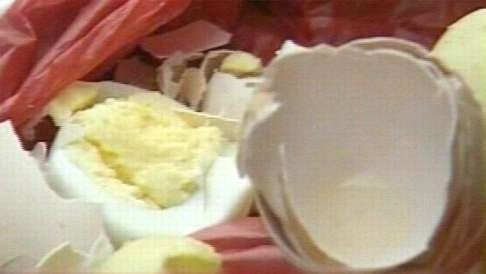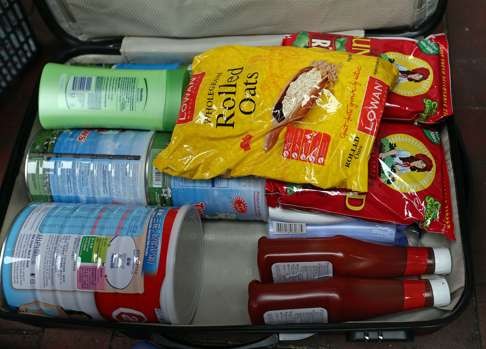
Criminal gangs are making huge profits using one of the oldest tricks to deceive shoppers
Fake or adulterated food is pervasive on our consumer shelves, according to experts
For your base mix, take some sodium alginate, add water, and stir for 90 minutes; add gelatin and leave for 10 hours; finally, add sodium benzoate and alum, and some lactones to taste. Now you are ready. Add some yellow colouring agent, and pour mix into small round moulds. Dip in calcium chloride to thicken. When these have firmed, dip into the original uncoloured base mix in an egg-shaped mould. Finally, dip this in a mixture of paraffin wax and gypsum, for a nice shiny hard shell.
And there you have it: an egg. Produced in 24 hours and at a quarter of the cost of letting a chicken poop it out naturally. Oh, and by the way – if you dye your base mix green, you have fake grapes too. Welcome to the world of food fraud.
When I first heard of Chinese fake eggs in 2011, I really could not believe it. The sheer ingenuity of it. The astonishing reality that a chemist can make an egg more cheaply than a hen.
New Zealand’s exporters of the rare and expensive manuka honey ...recently had to confront awkward questions from their loyal customers worldwide
Of course, most food fraud and adulteration is much less ingenious. It may just be a matter of adding water to bulk up the weight of some ham, or pouring cheap canola into extra virgin olive oil, or taking farmed salmon and calling it wild catch. And of course such frauds are not new: in ancient Rome, wine sellers added lead to sour wine to hide the fact that it had gone off – perhaps a reason why so many of Rome’s wealthy classes were sterile and mentally retarded.

According to Richard Evershed, professor of biochemistry at Bristol university in the UK, as you next wander down the aisle of a Parkn’shop or Wellcome supermarket, you need to bear in mind that in supermarkets worldwide, at least 10% of the products on the shelves have been adulterated. It is not that Parkn’shop and Wellcome are deliberately aiming to defraud or deceive us. It is that food adulteration is pervasive, and that food sellers are in a constant cat-and-mouse battle with food fraudsters to keep our food safe and honest: “We have created an ideal environment for criminals to operate within our global food system,” Evershed says with his collaborator Nicola Temple in their newly published book, Sorting the Beef from the Bull: the Science of Food Fraud Forensics.
In the US, the marine environmental group Oceana recently sampled 1,200 seafood products on sale in 674 retail outletsand found that 33% were mislabelled. That premium priced red snapper was actually farmed tilapia: much cheaper, and who is going to notice?
New Zealand’s exporters of the rare and expensive manuka honey – produced by bees that feed on New Zealand’s health-giving manuka tree – recently had to confront awkward questions from their loyal customers worldwide: if they manage to produce just 1,900 tonnes of manuka honey a year, how come world sales last year amounted to 9,070 tonnes?

China’s rice loving population consumes 127 million tonnes of rice per year. The country used to be self-sufficient, but since 2011 has been importing steadily more as people get richer, and as more grain is used to feed cattle for meat. A 10% increase in China’s rice imports, around 13m tonnes, would account for more than a third of the world’s 33 million tonne trade in rice. As shortages emerge, and prices rise, should we be surprised that imaginative chemists are making fake rice from plastic resin and potato starch?
Evershed estimates that food fraud costs the global food industry between US$10 billion to US$50 billion a year: “When a product is misrepresented, consumers are being cheated out of money, they are being cheated out of nutrition, and the legitimate producers are being cheated out of business.” And when it comes to melamine being added to milk, lives are being put at risk too.
As food adulteration problems increase, and governments step in with increasingly strict regulations and increasingly clever technologies to detect adulteration, so it is clear that food fraud problems will never be stamped out. As soon as a new smart test is invented, some smart fraudster with a strong financial incentive will invent some way of circumventing it.
Instead of throwing up hands in despair, Evershed provides six suggestions – all built around common sense – that may not eliminate fraud, but might certainly help us to protect ourselves against some of the worst dangers:

•First and most important, use your nose and your taste buds. Thousands of years of evolution have taught our senses to be very discriminating about things that are “not quite right”. Your taste “memory” is apparently incredibly sensitive. So instead of gulping food down, slow down, savour it, and use your inbuilt “food database” to check that something you buy, smell or taste is as you remember it.
•Buy whole, recognisable foods. It is easier to adulterate a pack of fish slices than a whole fish with its head still on. Processed foods are more easily adulterated than fresh products.
•Shorten the supply chain: the longer the supply chain, the bigger the opportunities for fraud and adulteration, and the harder for a consumer to have confidence in what he or she is buying.
•Buy from people you trust. Obvious, but nowadays not common.
•Avoid unrealistic prices: “we are sometimes delusional in terms of what food should cost,” says Evershed. If something is too cheap to be true, it probably is not true.
•Try to discover the “story” of the food you buy. The more you know about its story, the less likely you are going to be vulnerable to fraud.
Perhaps a last rule should be that we keep our food suppliers accountable. It should not just be you or me that walks down the supermarket aisle playing a game speculating on which products are adulterated. An average supermarket stocks around 30,000 products. That means at least 3,000 are adulterated. How easily should a supermarket manager sleep at night when he knows that?
David Dodwell is the executive director of the Hong Kong-Apec Trade Policy Group

